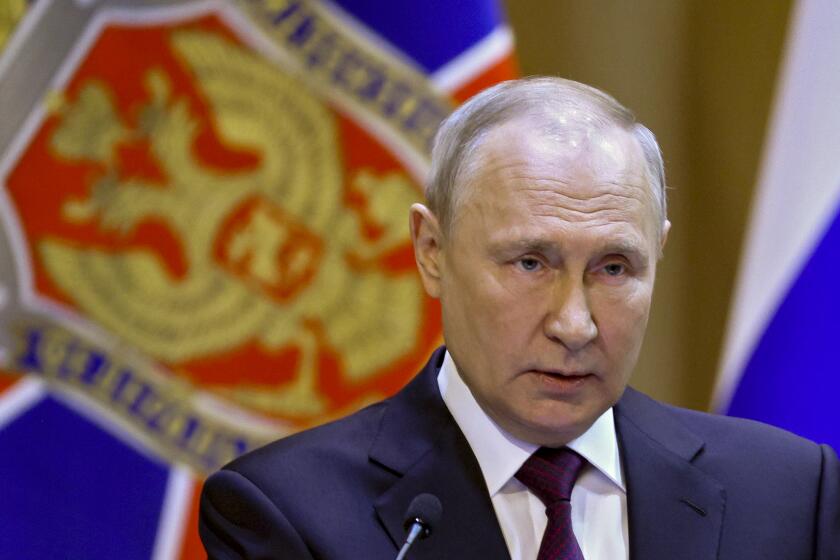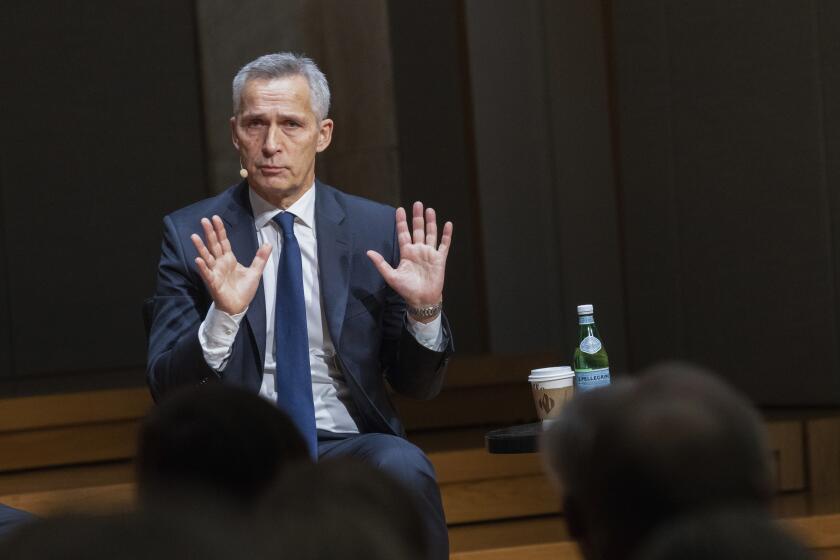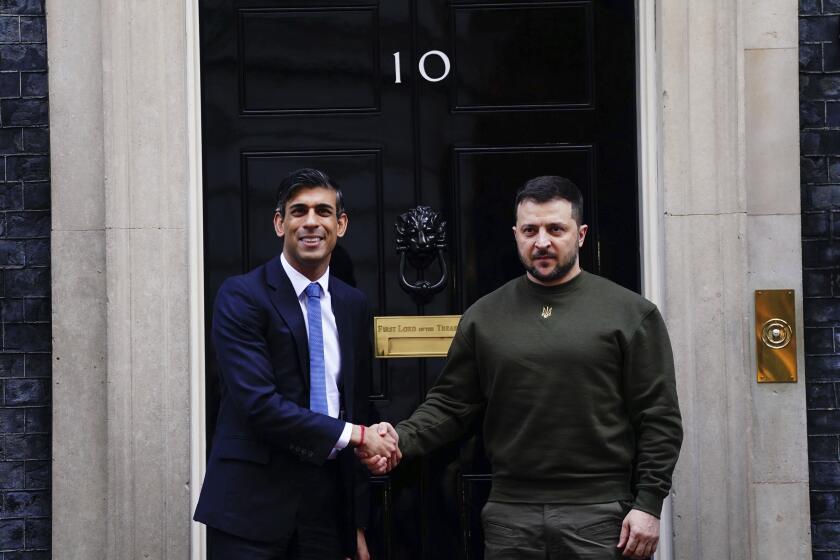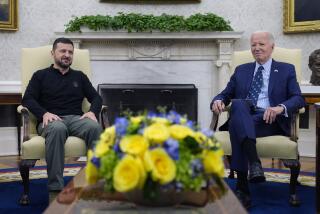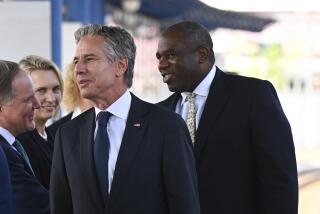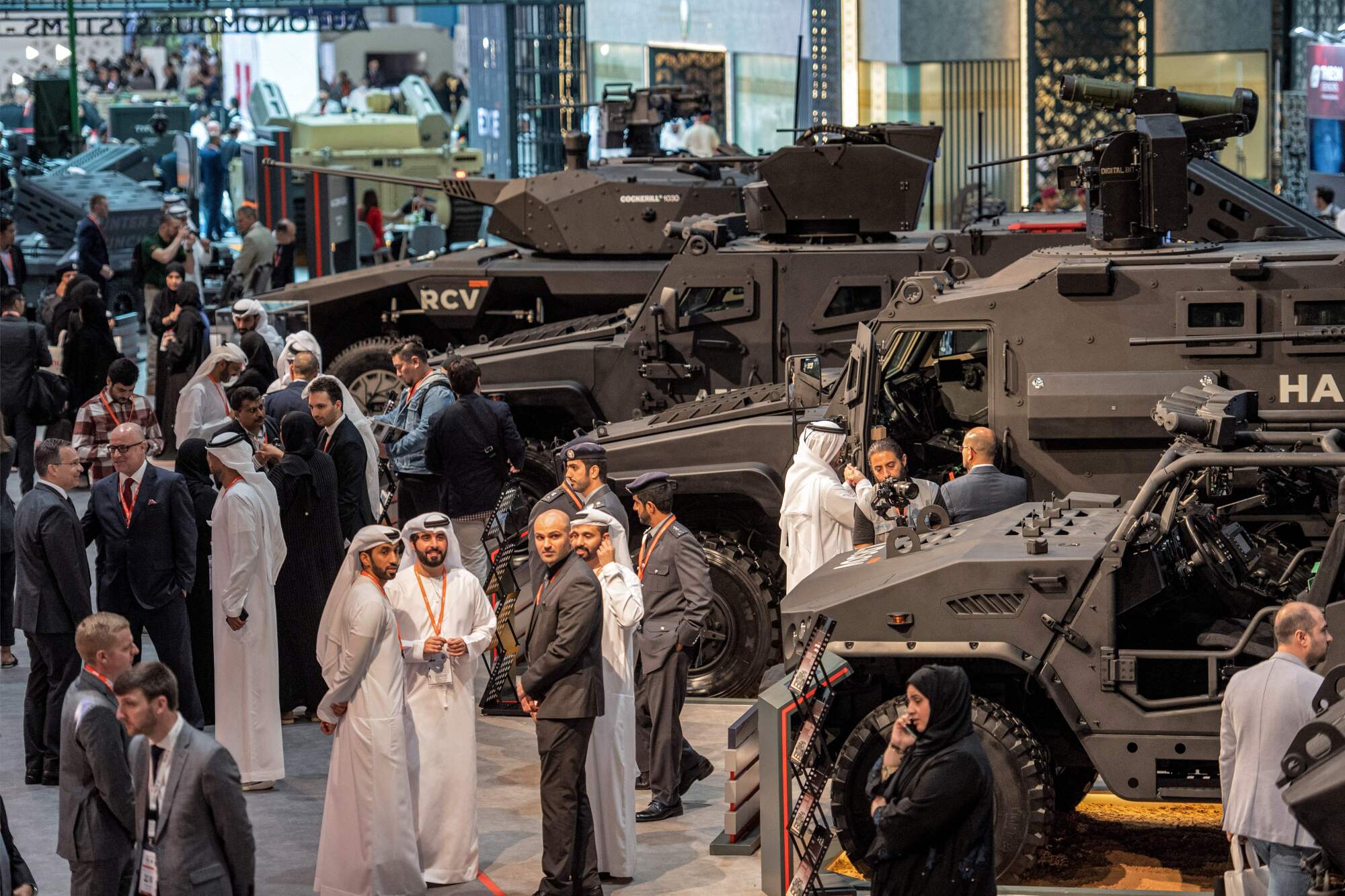
- Share via
ABU DHABI, United Arab Emirates — There’s always an element of the surreal at arms fairs. You catch it in the chipper tone of salespeople hawking new instruments of destruction; in the euphemisms — “defense” instead of “warfare,” “weapons platforms” rather than “guns” — sprinkled throughout glossy brochures; in the mini-lesson given by a jovial ex-soldier on best practices for operating an antitank missile system.
Now, there’s the added frisson of Europe’s biggest terrestrial armed conflict in decades — namely, Russia’s invasion of Ukraine, which has made one thing clear: Nothing invigorates the business of war like a war.
The combat in Ukraine, now in its second year, has jacked the global arms trade, fueling a new appetite for materiel not just in Moscow and Kyiv but also around the world as nations gird themselves for possible confrontations. The war has rocked long-standing relationships within the weapons industry, rejiggered the calculations of who sells what to whom and changed customers’ tastes in what they want in their arsenal.
Signs of those shifts abounded at last week’s International Defense Exhibition and Conference, or IDEX, the biennial arms bazaar held in the Emirati capital, Abu Dhabi. This year’s show was the largest in the event’s 30-year history, organizers said, bringing in 1,350 companies, 350 delegations and about 130,000 attendees from 65 countries.
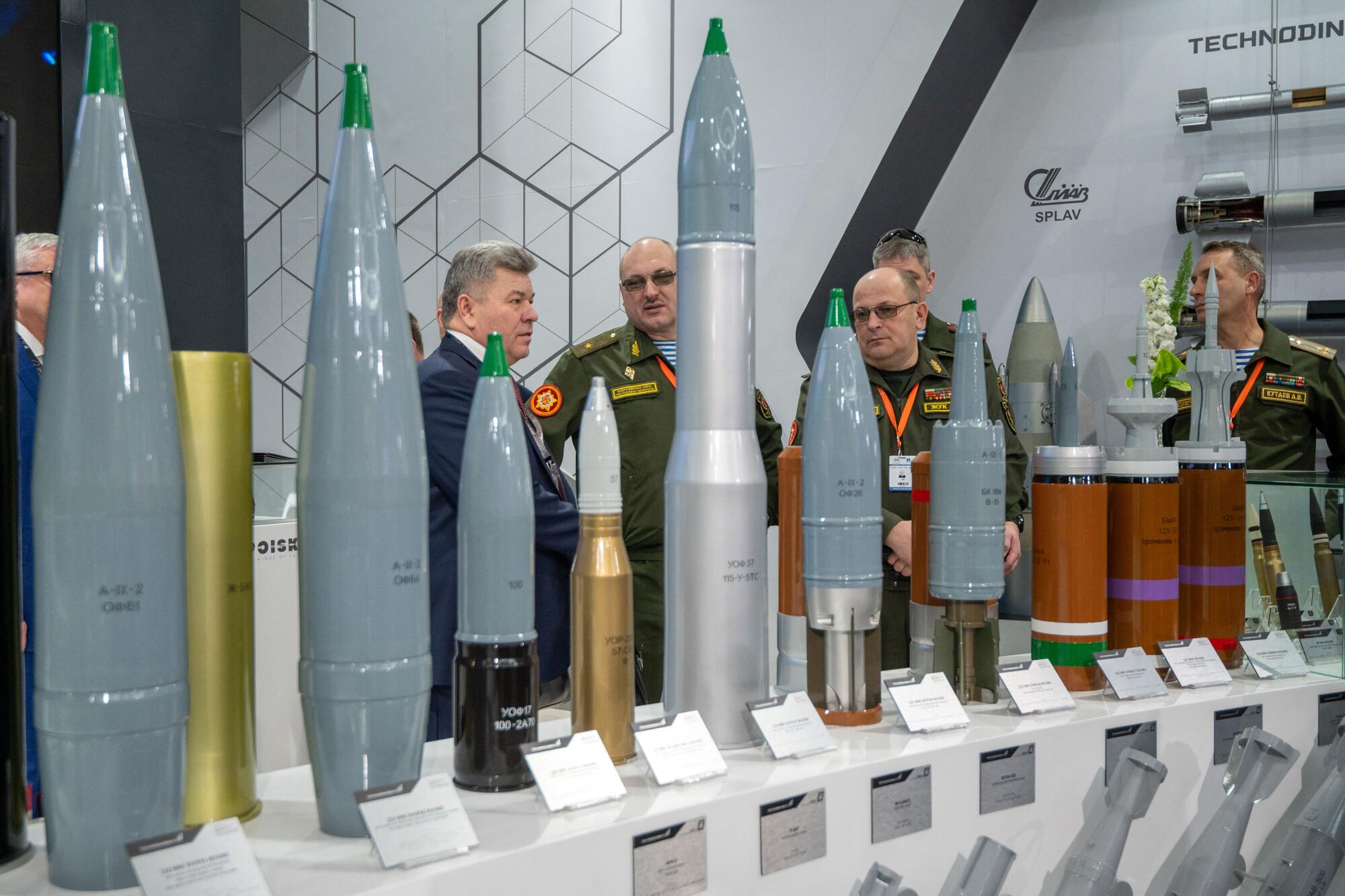
They flooded Abu Dhabi’s national exhibition center with enough armored vehicles, attack aircraft and air, land and sea drones to equip a not-so-small army.
Defense spending is surging in European nations seeking to keep up stocks at home while helping to arm Kyiv with rocket launchers, missiles and tanks. The German government has shaken off its usual hesitancy regarding military matters and pledged to spend $100 billion on reequipping its armed forces, though no money has yet been spent on weaponry.
In Asia, Japan and South Korea are boosting military spending in response to China, whose defense budget grew by 7% in 2022. That translates into Beijing’s largest-ever annual increase in absolute terms — $16 billion, adjusted for inflation, according to a report by the London-based International Institute for Strategic Studies.
Russian President Vladimir Putin signs bill suspending his country’s participation in the last remaining nuclear arms treaty with the United States.
Weapons companies are seeing their shares rise on the stock market to their best level in years, with indexes for the defense sector outperforming those tracking the broader market by a wide margin, experts say. That reverses a trend before the year-old Ukraine war of people putting their money in so-called ESG investments — those focusing on the environment and social and corporate governance — rather than the defense industry, said Kevin Craven, who heads the ADS Group, a trade organization representing British aerospace, defense, security and space companies.
“Now, one year on, you find people remembering that a government’s first duty is to defend its citizens, and actually the freedoms that we have require a strong military capability and defense industry,” Craven said.
He added that Britain’s robust support for Ukraine — it’s the second-largest contributor of military assistance after the U.S., supplying antitank missiles, artillery and armored vehicles — has generated interest in those products from prospective buyers.
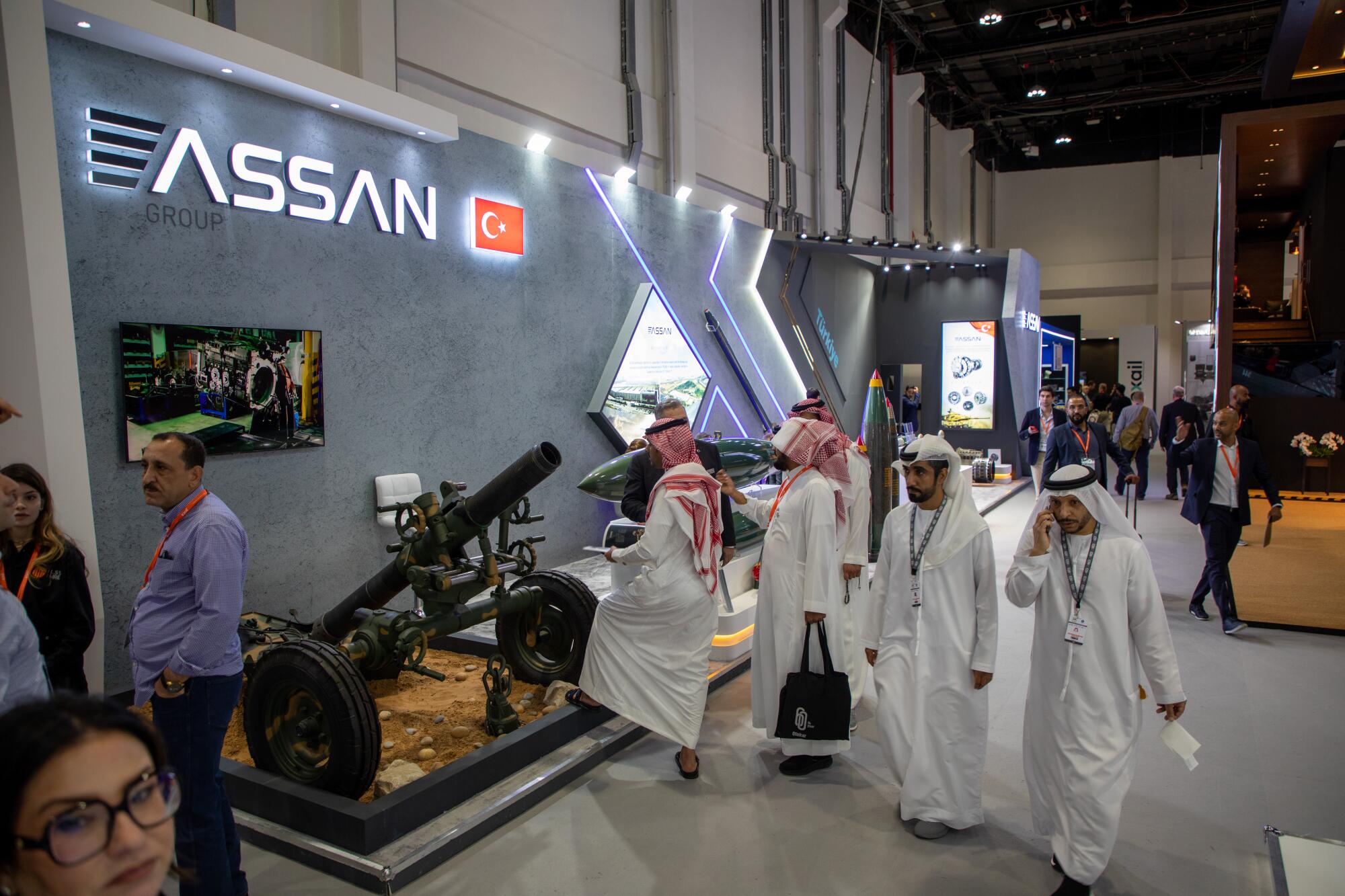
Emirati officials insisted that the event was about commerce, not geopolitics. During his visit to the fair, Emirati President Mohammed bin Zayed al Nahyan said it highlighted the Emirates’ “approach of building bridges of communication and cooperation” so as to achieve “peace, stability and a better future for humanity,” according to local media — despite the lethal nature of the merchandise.
An example of new cooperation would be the Emirates’ growing military relationship with Israel, which had no fewer than 60 companies in its pavilion. The two nations, which formally recognized each other less than three years ago, have embarked on joint weapons development; at IDEX, the Emirati defense conglomerate Edge debuted an unmanned boat it had worked on with Israel Aerospace Industries.
But the war in Ukraine has made business with Russia a tricky one. The Emirates, a top regional ally of the U.S. that has sought deeper military links with Washington, risked backlash by welcoming a significant portion of Russian business — along with many emigres — blacklisted by the West.
Washington sent Treasury officials to the Emirates in January to warn Abu Dhabi that it would “continue to aggressively enforce its sanctions” against Russian individuals and institutions, and that companies doing business in what it called “permissive jurisdictions” could risk losing access to U.S. and European markets. Last week, it imposed sanctions on a Russian bank recently allowed to begin operations in the Emirates.
The head of NATO has expressed worry that the fighting in Ukraine could spin out of control and become a ‘full-fledged war’ between Russia and NATO.
Despite the international sanctions, Moscow dispatched its top defense firms to Abu Dhabi. In what was perhaps a nod to political sensitivities, their displays were placed in the outdoor area of the convention — a roughly seven-minute walk and a sky bridge away from the Ukrainian and American pavilions in the main exhibition area.
To one side of Russia’s display, a quartet of blond women urged visitors to check out civilian versions of helicopters from manufacturers Mil and Kamov as a giant screen showed footage of their military counterparts in combat. On the other side was a large tent that served as a dedicated pavilion to Russian firms Kalashnikov, Rosoboronexport and Almaz-Antey, which brought in about 200 full-scale samples of weapons, military equipment and ammunition, including many examples of the materiel now deployed in Ukraine.
Inside the tent, dozens of prospective customers — Algerian generals, representatives of several Asian countries, paunchy men surrounded by grim-faced bodyguards — milled around dioramas featuring Grad missile launchers and checked out shelves lined with weapons.
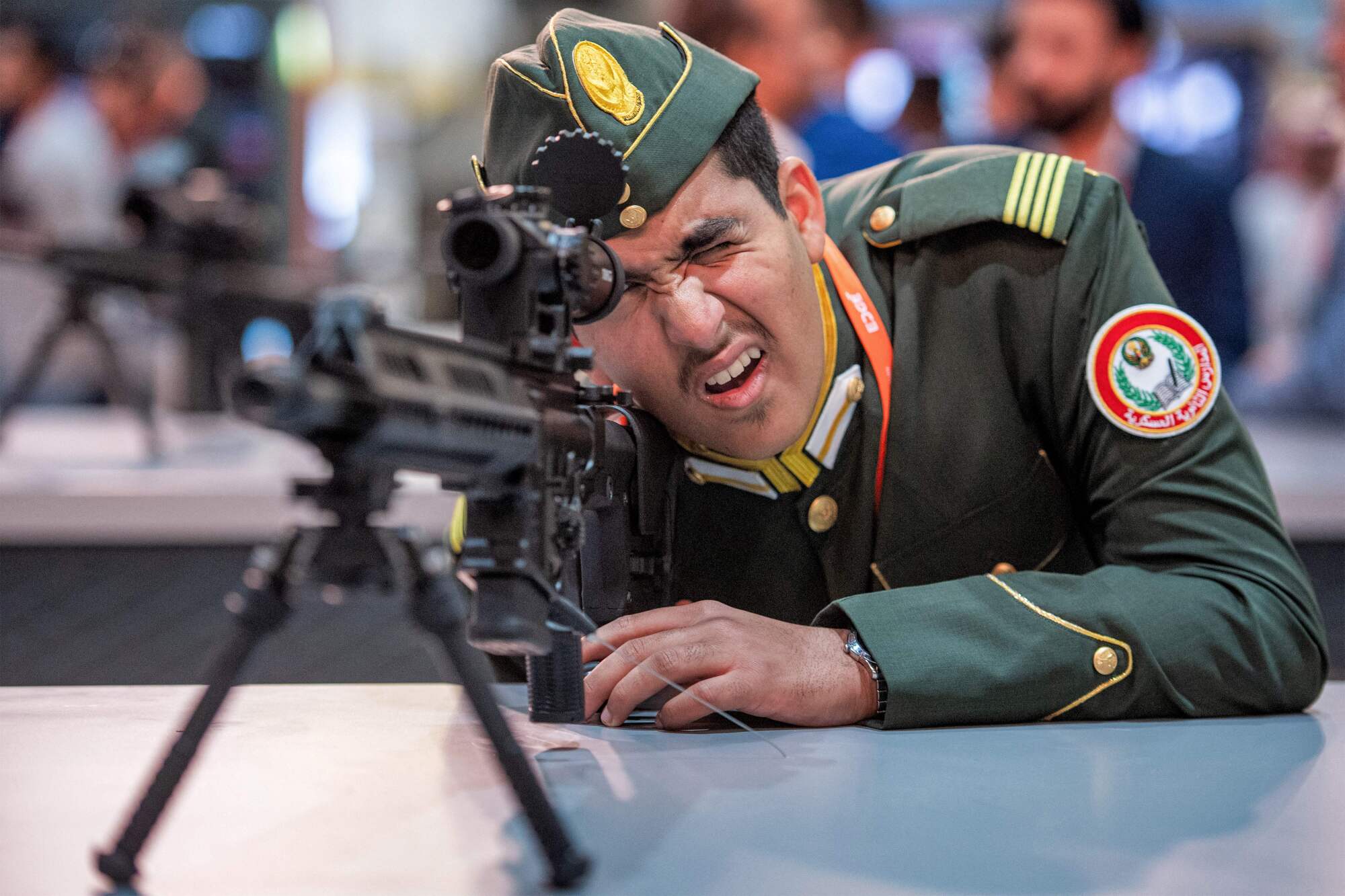
“The sanctions situation creates a certain closed nature of relationships, negotiations, and we try not to talk about it. But we can say with confidence Russian weapons are in great demand and authority,” Rosoboronexport Chief Executive Alexander Mikheev told Russian state news agency Tass. “That’s why we are here: in order to maintain relations with our partners.”
The weapons showcased at IDEX underscored how the war has shifted development toward loitering munitions, cheaply made exploding drones that can monitor the battlefield from above and then ram themselves into a target. In recent months, Russia deployed Iranian-made exploding drones in a devastating campaign against Ukrainian infrastructure. (Iran did not participate in IDEX.)
“The entire product line of the group is in demand, but unmanned aerial vehicles are the priority,” Alan Lushnikov, president of Russia’s Kalashnikov Group, said in an interview with Tass, adding that the company’s KUB exploding drone was its top seller.
Ukrainian President Volodymyr Zelensky sought support in a surprise European tour, pushing for fighter jets to battle Russian invaders in a dramatic speech to the U.K. Parliament.
“The volume of orders has grown significantly,” Lushnikov said. “The group’s enterprises are working in a more intensive mode.”
Neither Lushnikov nor Rosoboronexport chief Mikheev were made available to The Times for interviews despite repeated requests.
Faisal Bannai, who heads the Emirati conglomerate Edge, said the war in Ukraine proved how essential autonomous systems and electronic warfare were becoming for client nations.
“That’s where the market is. That’s where the future is,” Bannai said, adding: “I can sell ammunition or a bomb, but that’s not where the main volume of my business is coming from.”
Bahadir Ozer, a business development director for Turkish drone manufacturer Baykar, agreed that the war in Ukraine has “been a huge advertisement for us.”
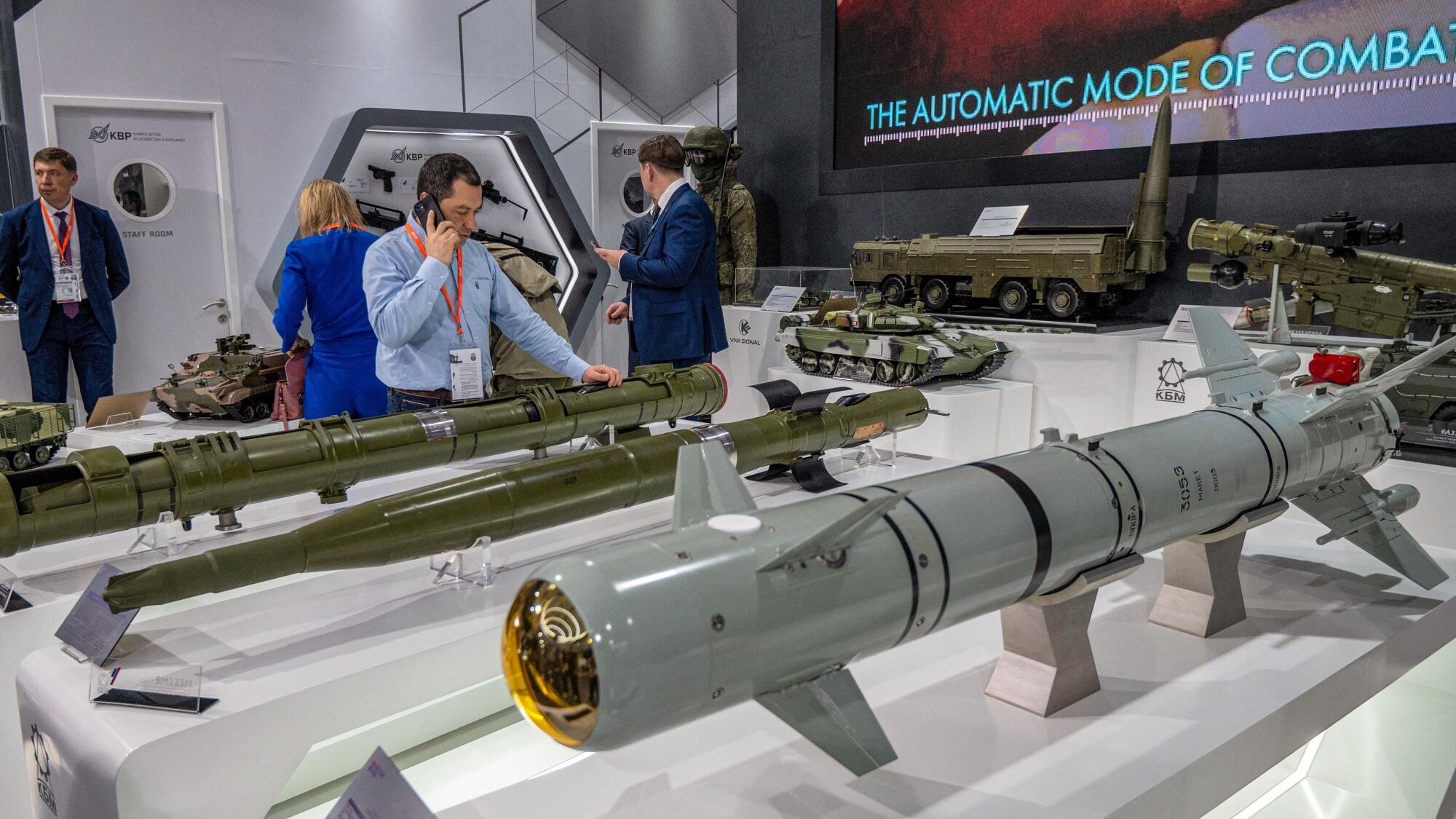
Even before the conflict started, the company was supplying Kyiv with its Bayraktar TB2 drone, a relatively low-cost unmanned aerial vehicle that had been deployed to great effect in conflicts such as those in Nagorno-Karabakh, Libya and Syria. It proved to be no less lethal against Russia’s armor in Ukraine — so much so that some Ukrainians rhapsodized its prowess in song.
“The TB2 has been successful for a long time, but the difference now is that we got the attention of the West,” Ozer said, adding that NATO member Poland and 28 other countries have purchased Bayraktar drones. More nations are interested.
“They’re combat-proven — that’s been a big deal,” Ozer said.
Even Ukraine, despite being under attack by Russia for more than a year, was represented in Abu Dhabi. Stanislav Shyldskyi, a business development manager with drone manufacturer Ukrspec, described the moment when Russian journalists came to check out the Ukrainian pavilion in the main convention center.
Start your day right
Sign up for Essential California for the L.A. Times biggest news, features and recommendations in your inbox six days a week.
You may occasionally receive promotional content from the Los Angeles Times.
“They told us, ‘You guys don’t have anything.’ They wrote an article the next day that the Ukrainian pavilion is very small,” Shyldskyi said. “It was pretty childish, and we told them to stop filming.”
He said most of what Ukrainian firms were producing was going toward domestic consumption, but it was still important to be at an arms show such as IDEX.
“It’s a good time for us to be here to show the world that we’re alive, working, making great products,” he said. “The war is making people know about Ukraine. It’s not the best thing. But of course they’re more interested.”
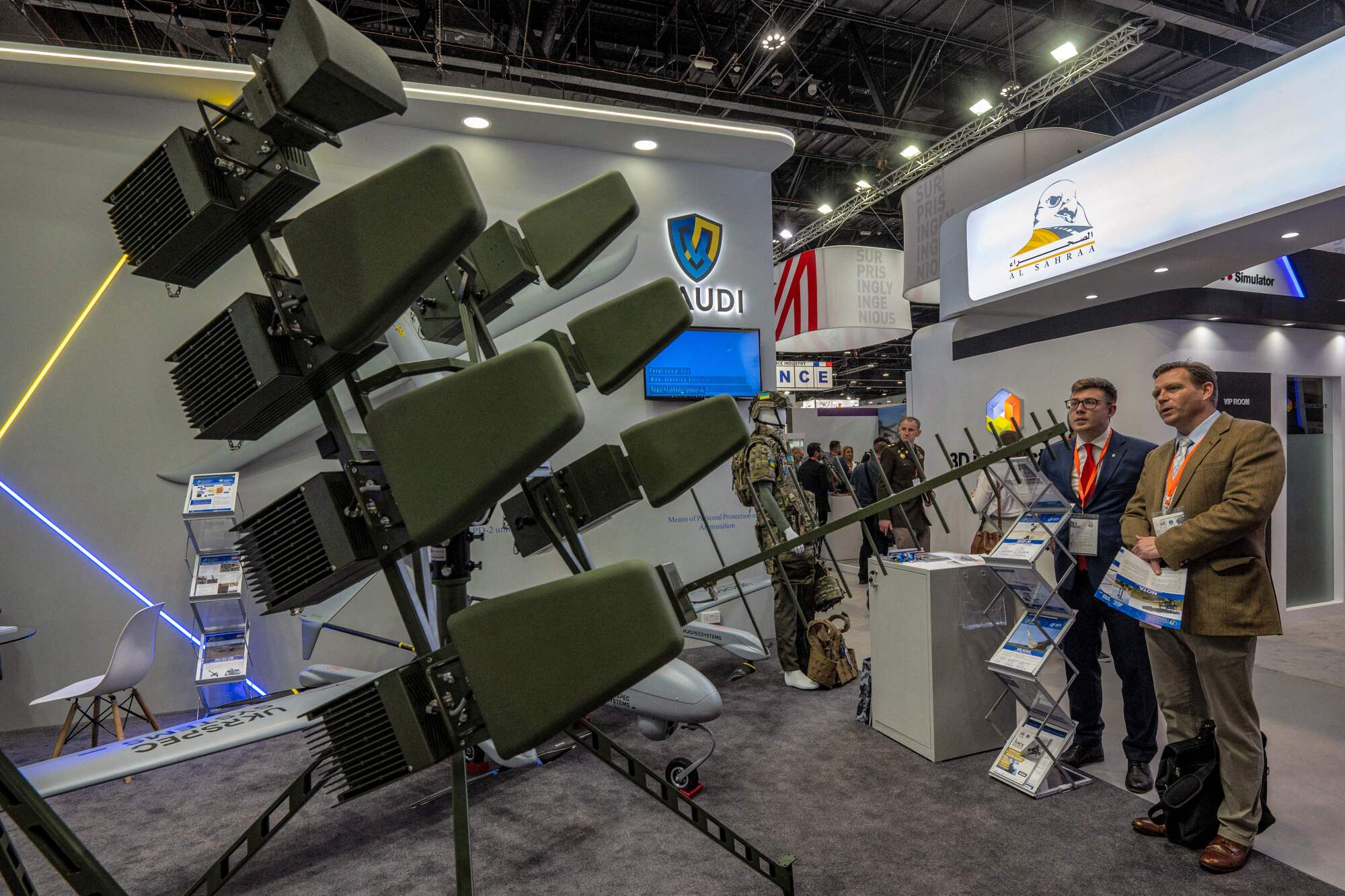
Not far from the Ukrainian pavilion, Belarus, which has sided with Russia in the conflict, occupied a larger corner stand with several meeting rooms. One of the half-dozen sales representatives there said sanctions had done little to hamper their trade.
“We actually got more interest after sanctions. If someone wants to sanction you, it means we are strong,” he said, adding that the prohibitions had been an impediment only in the first two months of their application. He spoke on condition of anonymity to comment on geopolitical matters.
“We expected it would be more difficult to do business, but when there’s interest, a client will always find a way to make it work.”
More to Read
Sign up for Essential California
The most important California stories and recommendations in your inbox every morning.
You may occasionally receive promotional content from the Los Angeles Times.
